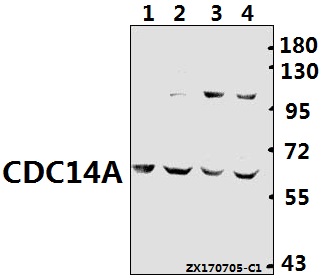Product Name :
CDC14A polyclonal antibody Background :
In budding yeast, the Cdc14a phosphatase activates mitotic exit by dephosphorylation of specific cyclin-dependent kinase (Cdk) substrates and seems to be regulated by sequestration in the nucleolus until its release during mitosis. Human Cdc14a phosphatase is highly similar to Saccharomyces cerevisiae Cdc14 and is a member of the dual specificity protein Tyrosine phosphatase family. It interacts with and dephosphorylates tumor suppressor protein p53 and may regulate the function of p53. In addition, Cdc14a dephosphorylates hCdh1 and activates APCCdh1. Cdc14a phosphatase plays a role in the regulation of the centrosome cycle, mitosis and cytokinesis, thereby influencing chromosome partitioning and genomic stability in human cells. Deregulated human Cdc14a phosphatase disrupts centrosome separation and chromosome segregation. Product :
Rabbit IgG, 1mg/ml in PBS with 0.02% sodium azide, 50% glycerol, pH7.2 Storage&Stability :
Store at 4°C short term. Aliquot and store at -20°C long term. Avoid freeze-thaw cycles. Specificity :
CDC14A polyclonal antibody detects endogenous levels of CDC14A protein. Immunogen :
Synthetic peptide, corresponding to amino acids 150-200 of Human CDC14A. Conjugate :
Unconjugated Modification :
Unmodification
CDC14A polyclonal antibody Background :
In budding yeast, the Cdc14a phosphatase activates mitotic exit by dephosphorylation of specific cyclin-dependent kinase (Cdk) substrates and seems to be regulated by sequestration in the nucleolus until its release during mitosis. Human Cdc14a phosphatase is highly similar to Saccharomyces cerevisiae Cdc14 and is a member of the dual specificity protein Tyrosine phosphatase family. It interacts with and dephosphorylates tumor suppressor protein p53 and may regulate the function of p53. In addition, Cdc14a dephosphorylates hCdh1 and activates APCCdh1. Cdc14a phosphatase plays a role in the regulation of the centrosome cycle, mitosis and cytokinesis, thereby influencing chromosome partitioning and genomic stability in human cells. Deregulated human Cdc14a phosphatase disrupts centrosome separation and chromosome segregation. Product :
Rabbit IgG, 1mg/ml in PBS with 0.02% sodium azide, 50% glycerol, pH7.2 Storage&Stability :
Store at 4°C short term. Aliquot and store at -20°C long term. Avoid freeze-thaw cycles. Specificity :
CDC14A polyclonal antibody detects endogenous levels of CDC14A protein. Immunogen :
Synthetic peptide, corresponding to amino acids 150-200 of Human CDC14A. Conjugate :
Unconjugated Modification :
Unmodification
-
 Western blot (WB) analysis of CDC14A polyclonal antibody at 1:500 dilution Lane1:C6 whole cell lysate(40ug) Lane2:MEF whole cell lysate(40ug) Lane3:K562 whole cell lysate(40ug) Lane4:HEK293T whole cell lysate(40ug)
Western blot (WB) analysis of CDC14A polyclonal antibody at 1:500 dilution Lane1:C6 whole cell lysate(40ug) Lane2:MEF whole cell lysate(40ug) Lane3:K562 whole cell lysate(40ug) Lane4:HEK293T whole cell lysate(40ug)
Bioworld Biotech only provide peptides for our antibodies and do not provide additional peptide customization services.
Price/Size :
USD 368/1mg/vial
Tips:
For phospho antibody, we provide phospho peptide(0.5mg) and non-phospho peptide(0.5mg).Describe :
Blocking peptides are peptides that bind specifically to the target antibody and block antibody binding. These peptide usually contains the epitope recognized by the antibody. Antibodies bound to the blocking peptide no longer bind to the epitope on the target protein. This mechanism is useful when non-specific binding is an issue, for example, in Western blotting (WB) and Immunohistochemistry (IHC). By comparing the staining from the blocked antibody versus the antibody alone, one can see which staining is specific; Specific binding will be absent from the western blot or IHC performed with the neutralized antibody.Formula:
Synthetic peptide was lyophilized with 100% acetonitrile and is supplied as a powder. Reconstitute with 0.1 ml DI water for a final concentration of 10 mg/ml.The purity is >90%,tested by HPLC and MS.
Storage:
The freeze-dried powder is more stable. For short time at 2-8°C. For long term storage store at -20°C.
Note :
This product is for research use only (RUO only). Not for use in diagnostic or therapeutic procedures.
 CDC14A polyclonal antibody
CDC14A polyclonal antibody  Datasheet
Datasheet COA
COA MSDS
MSDS SHIP
SHIP